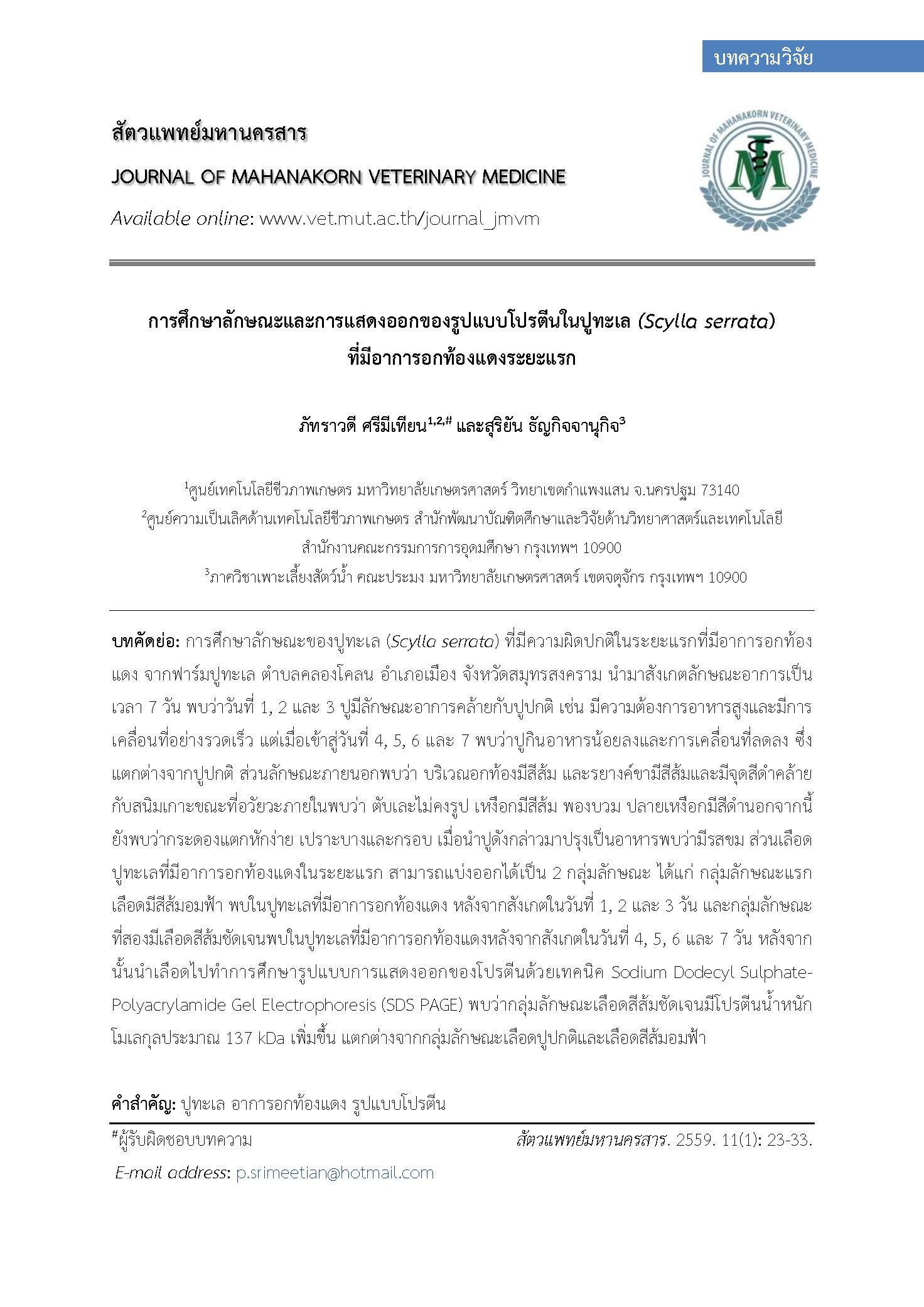Characters and Protein Profile in the First Stage of Mud Crab (Scylla serrata) Infected by Red Sternum Syndrome
Main Article Content
Abstract
The first stage of mud crabs infected by red sternum symptom and normal mud crabs were collected from a farm in Samut Songkhram province, Thailand and their used to study in external-internal morphological characterization and their behavior. The symptoms of red sternum syndrome showed orange color of abdominal thorax, black spots on joints and very thin carapace. In internal organs were dark and soft as well as bitter meats. The behavior of mud crab were normal feeding and moving at 1st to 3rd day after infected by the syndrome. While 4th to 7th day after infected found that mud crabs were lose appetite and limited moving. The color blood of those crabs were classified into two groups; orange-blue (group I: 1st to 3rd day) and orange (group II: 4th to 7th day). To determine the protein expression of red sternum and normal mud crabs using Sodium Dodecyl Sulphate-Polyacrylamide Gel Electrophoresis (SDS PAGE) found that during 1st to 3rd day after red sternum syndrome infection demonstrated that the pattern of proteins were same as normal crab, while 4th to 7th day after infection showed that the additional protein was found compared to normal mud crab, approximately 137 kDa.
Article Details
References
Ayres, P. and Edwards, E. 1982. Notes on the distribution of ‘‘black spot” shell disease in crustacean fisheries. J. Chem. Ecol. 1: 125-130.
Bradford, M.M. 1976. A Rapid and sensitive method for the quantitation of microgram quantities of protein utilizing the principle of protein-dye binding. Anal. Biochem.72: 248-254.
Costa-Ramos, C. and Rowley, A. F. 2004. Effect of Extracellular Products of Pseudo-alteromonas atlantica on the Edible Crab Cancer pagurus. Appl. Environ. Microbiol. 70(2): 729-735.
Department of Fisheries. 2015. http://www. fisheries.go.th/. 12 December 2015.
Intanakom, J. 2010. Study on morphological, bacterial identification and histology in mud crab (Scylla sp.) with red thoracic-abdominal syndrome. The thesis of Kasetsart University.Bangkok. 93 p. (in Thai)
Klose, J. 1975. Protein mapping by combined isoelectric focusing and electrophoresis of mouse tissues. A novel approach to testing for induced point mutations in mammals. Humangenetik. 26(3): 231-243.
Laemmli, U.K. 1970. Cleavage of structural proteins during the assembly of the head of bacteriophage T4. Nature. 227: 680-685.
Liu, W., Qian, D. and Yan, X. 2011. Protemic analysis of differentially expressed proteins in hemolymoh of Scylla serrata response to white spot syndrome virus infection. Aquaculture. 314: 53-57.
Martin, G.G., Hose, J.E., Omori, S., Chong, C., Hoodbhoy, T. and McKrell, N. 1991. Localization and roles of coagulogen and transglutaminase in hemolymph coagulation in decapods crustaceans. Comp Biochem Physiol. 100(B): 517-522.
Merzendorfer, H. and Zimoch, L. 2003. Chitin metabolism in insects: structure, function and regulation of chitin synthases and chitinases. J. Exp. Biol. 206: 4393-4412.
Meyers, T.R., Koeneman, T.M., Botelho, C. and Short, S. 1987. Bitter crab disease: a fetal dinoflagellate infection and marketing problem for Alaska tanner crabs Chionoecetes bairdi. Dis. Aquat. Organ. 3: 195-216.
Noga, E.J., Engel, D.P., Arroll, T.W., McKenna S. and Davidian, M. 1994. Low serum antibacterial activity coincides with increased prevalence of shell disease in blue crabs Callinectes sapidus. Dis. Aquat. Organ. 19: 121-128.
Nonwachai, T. 2010. Growth, survival and non-specific immune characteristics of pacific white shrimp (Litopenaeus vannamei) fed with supplement Sehizochytrium sp. and ARA containing diets, and challenged with Vibrio harveyi. The thesis of Kasetsart University.Bangkok. 113 p. (in Thai)
Plainpun, N. 2014. Induction of red thoracic – abominal syndrome with bacteria isolated from mud crab (Scylla sp.). The thesis of Kasetsart University. Bangkok. 121 p. (in Thai)
Qiao, J., Du, Z., Zhang Y., Du H., Guo L., Zhong M., Cao J. and Wang X. 2011. Proteomic identification of the related immune-enhancing proteins in shrimp Litopenaeus vannamei stimulated with vitamin C and Chinese herbs. Fish & Shellfish Immunol. 31: 736-745.
Ryazanova, T.V. 2008. Bitter crab syndrome in two species of king crabs from the Sea of Okhotsk. Russ. J. Mar. Biol. 34: 411-414.
Salaenoi, J., Sangcharoen, A., Thongpan, A. and Mingmuang, M. 2006. Morphology and haemolymph composition changes in red sternum mud crab (Scylla serrata). KasetsartJ. (Nat. Sci.) 40: 158-166.
Söderhäll, K. and Cerenius, L. 1998. Role of the prophenoloxidase-activating system in invertebrate immunity. Curr Opin Immunol. 10: 23-28.
Somboonwiwat, K., Chikeeratisak, V., Wang, H.C., Lo F.C. and Tassanaka, A. 2010. Proteomic analysis of differentially expressed proteins in Penaeus monodon hemocytes after Vibrio harveyi infection. Proteome Sci. 8: 1-11.
Srimarksuk A. 2012. Growth, survival, non-specific immune characteristics and resistance to Vibrio harveyi of pacific white shrimp (Litopenaeus vannamei) fed with yeast cell debris. The thesis of Kasetsart University.Bangkok. 114 p.
Stentiford, G.D., Green, M., Bateman, K., Small, H.J., Neil, D.M. and Feist, S.W. 2002. Infection by a hematodinium-like parasitic dinoflagellate causes pink crab disease (PCD) in the edible crab Cancer pagurus. J. Invertebr. Pathol. 79: 179-191.
Taylor, A.C., Field, R.H. and Parslow-Williams, P.J. 1996. The effects of Hemato-diniumsp infection on aspects of the respiratory physiology of the Norway lobster, Nephrops norvegicus (L.). J. Exp. Mar. Biol. Ecol. 207: 217-228.
Thammasirirak, S. 2002. Proteomics. KKU Sci. J. 30(3): 160-168. (in Thai)
Vogan, L. C., Costa-Ramos, C. and Rowley, A. F. 2002. Shell disease syndrome in the edible crab, Cancer pagurus – isolation, characterization and pathogenicity of chitinolytic bacteria. Microbiology. 148:743-754.
Xu,W., Xie, J.,Shi H. and Li, C. 2010. Hematodinium infections in cultured ridgetail white prawns, Exopalaemon carinicauda, in eastern China. Aquaculture. 300: 25-31.

